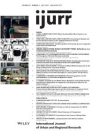Race and ethnicity are regularly encoded in the value of urban spaces, serving as key factors in the calculus of economic and political elites who determine the market and social value of such spaces. However, urbanists[1] in many parts of the world frame racial inequalities as merely symptoms of economic inequality, if they mention race at all. The discourses and practices of a collection of scholars, government officials, urban planners and private developers reinforce the notion of “colorblind” or “race-neutral” urbanism, which fails to address race and racism as intrinsic features of urban development. While this narrative has become somewhat pervasive, as a result of a number of political and social factors, we are at a pivotal juncture that will engender its abatement.
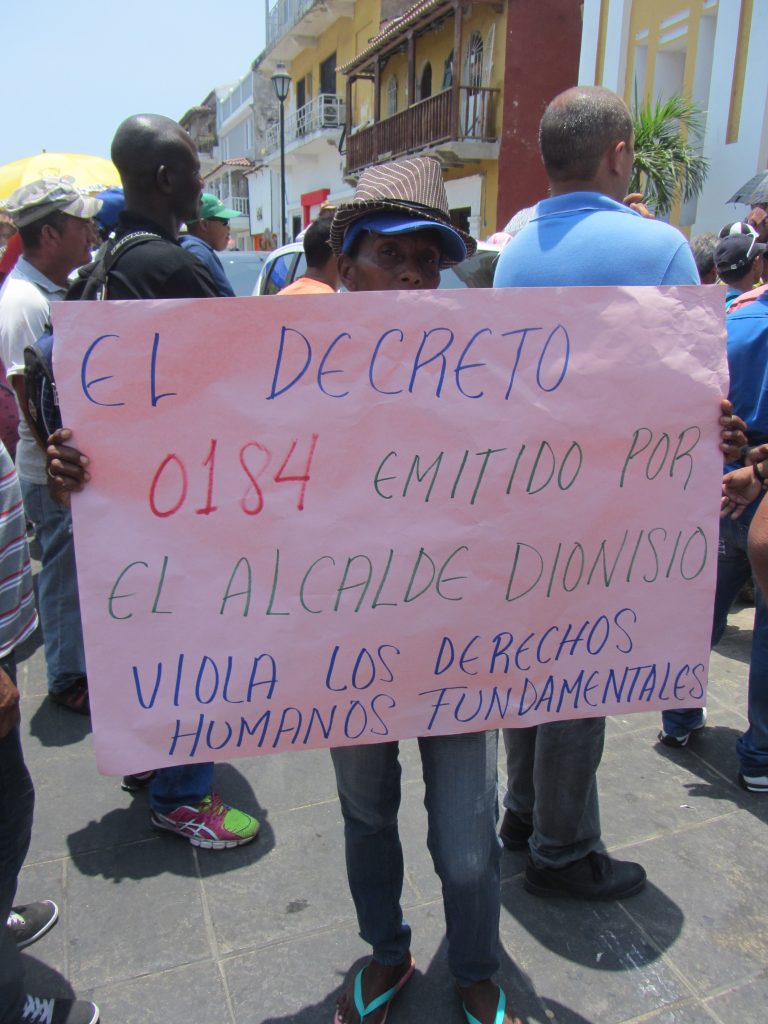
2014 Street vendors protest. Photo by Melissa Valle.
Differing racial ideologies, demographics and development histories have made race-neutrality in development more ubiquitous in certain parts of the world than others. I begin by discussing the prominence of race-neutral urbanism in the case of Latin America. I transition to examples in the Anglosphere (the US, the UK and South Africa) that call attention to a shift from understandings of development that embed race, to ones similar to the race-neutral urbanism employed in Latin American nations. I then delineate recent occurrences in the Americas and Europe that have the potential to disrupt colorblind narratives and practices. I broaden my scope to make references to sites around the globe in order to highlight the commonalities between race-neutral urbanism in various locations, to understand the context-specific dynamics that shape this form of urbanism, and to argue how race-neutral urbanism will be exposed as false.
The high correlation between race and class in many nations, combined with professed colorblind ideologies, allow those in positions of power to use class as a proxy for the silenced organizing category of race. In Latin America, for example, both urban scholarship and development practice have been shaped by a racial ideology that is centuries old. The mestizaje (race mixture) ideology has advanced a mythical narrative of colorblindness and racial democracy, all the while placing a premium on whiteness. As a result, with a few notable exceptions (see Valle, 2017 for a more extensive discussion), scholarship in Latin America about spatial inequalities and transformations typically do not address race as a central feature of development and struggles for justice at the urban scale. For example, we can see the removal of race and racism in discussions of one of the most prominent features of contemporary development in Latin America, the gated community. Social exclusion of any kind is rarely discussed in the production of these spaces by governments and real estate developers, except in the case of those who use exclusion as a marketing tool to tacitly signal that these communities have been sanitized and purged of unsafe, undesirable types and classes. While the extensive scholarship addressing the implications and dramatic increase in gated communities often refer to social exclusion and segregation, they typically make no mention of racial or ethnic segregation[2]. At times, these works go so far as to explicitly state that the segregation produced by these communities is strictly class-based, not racial or ethnic like it is in the United States. Such omissions in societies with pervasive racial inequalities ignore the ways in which the devaluation of racialized groups impacts how urban space becomes stratified. Those who are typically at the helm of decision-making then generate prescriptions about urban space that frequently induce and perpetuate significantly racialized injustices.
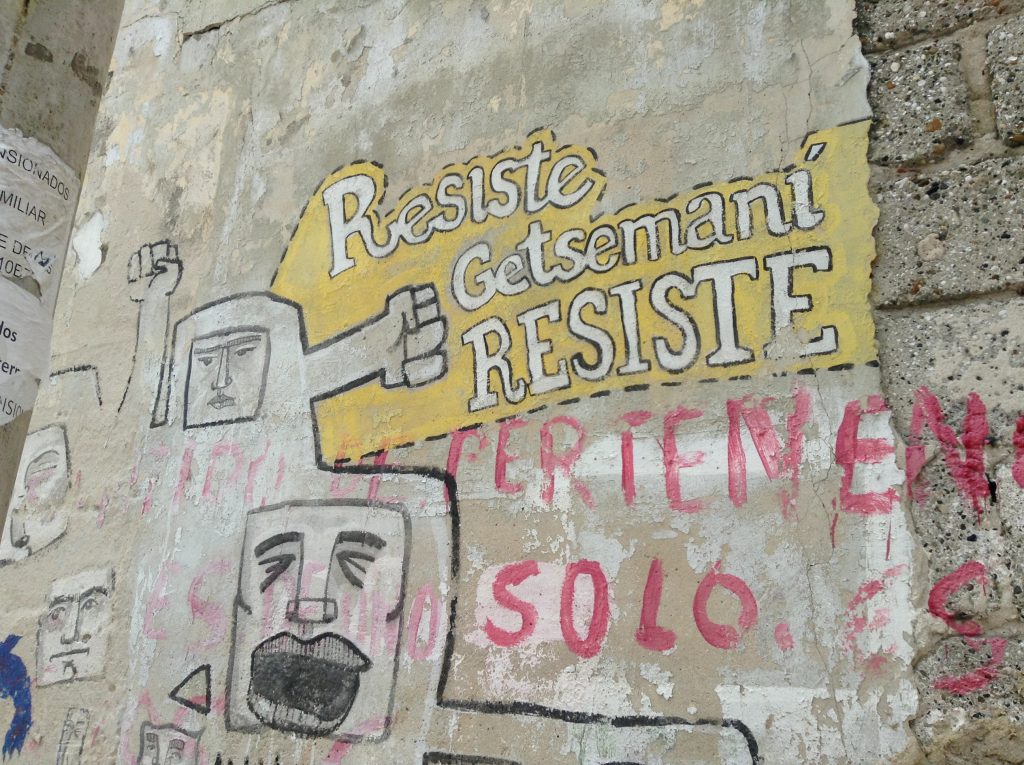
Getsemaní. Photo by Melissa Valle.
In certain places the pendulum has noticeably swung between recognizing and disregarding racism’s power in urban development. For well over a century, it had been widely acknowledged by scholars and policy makers in countries like the United States, England and South Africa that race was of great consequence in the shaping of urban space. In these contexts, the “ghetto” had been largely defined by its concentration of Black and Southeast Asian people living in poverty and had become synonymous with devalued ethnic enclaves. In the cases of the United States and South Africa, de jure racial residential segregation was a central feature of housing markets and uneven spatial development (Gotham, 2014). However, to simply acknowledge that race played a role in this uneven development does not necessarily mean that the forces of racial discrimination and racism have been accepted as significant contributing factors. Racial inferiority, with its attendant ideas about cultural and moral failings, were proffered as explanations for inequality and deprivation in cities by scholars and government agencies in the United States during the early 20th century social reform movement. These perceptions became acute in the 1960s and continued to proliferate in the 1970s and 80s as urban poverty became more concentrated. A number of US scholars and urban practitioners developed counterarguments to such racialized culture of urban poverty narratives. These counter narratives gained particular strength during the 1990s. By illuminating race and institutional racism, they enabled a critical assessment of the mediating material factors that are central to uneven development and the rescaling of urban space.
Nevertheless, the pendulum has again swung and both race and racism’s roles have progressively become elided in the aggregation of elements constituting the urban (re)development process in places that took race, and at times racism, into account. For example, during the first two decades of the twenty-first century in the United States, government officials and economic elites began to couple neoliberal urbanism with colorblind racial discourses to prevent impediments to “colorblind economic development, purportedly driven by the comprehensive and fair principles of the free-market but not the race-conscious needs of a declining city,” (Mele 2013, 607). Through the marriage of neoliberal urbanism and colorblind racial ideology, urbanists’ development processes and discourses perilously ignore the racial hierarchy. As a consequence, public policies and private resources are mobilized in ways that produce and reproduce racial inequality in urban space.
Despite the longstanding practice of ignoring race in development in most nations in Latin America and Europe, and the increasing shift in this direction by policy makers, scholars and urban developers in the US, in recent years, a confluence of conditions that are categorically racial in nature, consequences and/or broader reception is making it increasingly difficult for academics, policy makers and those in positions of economic power to perpetuate the myths fundamental to the functioning of the colorblind and neoliberal urbanism paradigm. These conditions include:
- The influx of increasingly racialized peoples subject to forced population transfer and economic migration;
- An acceleration of gentrification rooted in blatantly race-based development and displacement strategies in racialized neighborhoods throughout the US, Europe and Latin America;
- The rise of right-wing populism frequently made visible through an intensified anti-immigrant backlash and fascist, white nationalist and neo-Nazi movements and;
- Transnational anti-racist movements that explicitly confront racial injustice, especially as it relates to violence at the hands of police.
Below, I briefly explicate how each one of these factors has the potential to sublimate the race-neutral discussions around urban spatial (re)development, and subsequent policy, program and scholarship prescriptions, into ones that are framed around an understanding of what Gotham (2014) describes as “a racialized process that is activated and reproduced through the concrete decisions and actions taken by state actors, elected leaders, economic elites and other powerful organized interests” (p. 775).
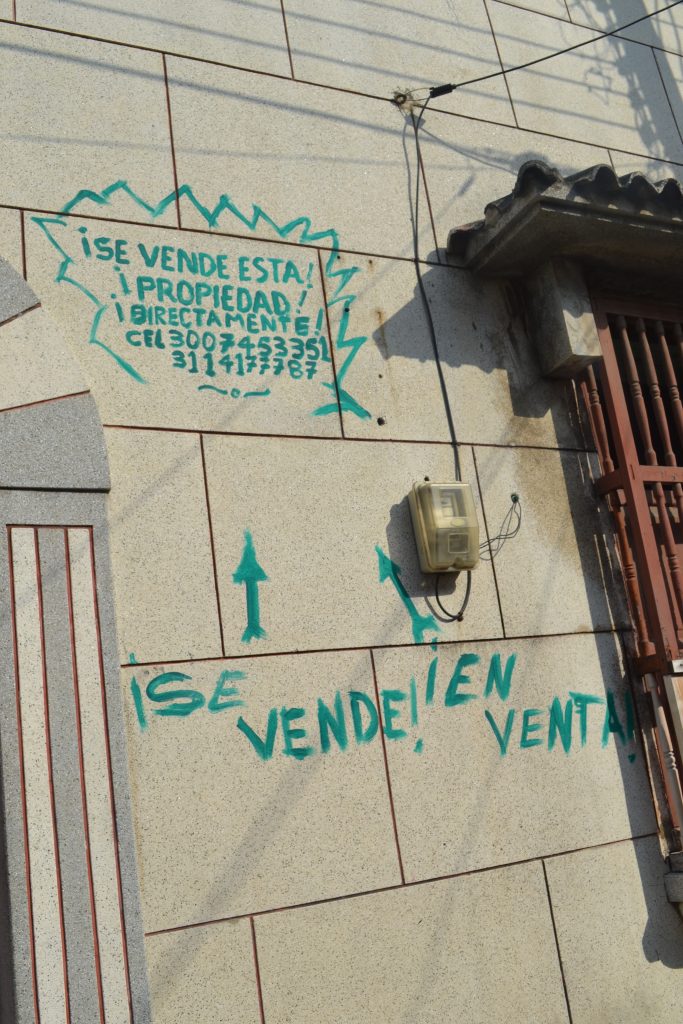
Getsemaní. Photo by Melissa Valle.
Forced population transfer and the economic migration of racialized peoples
While the majority of refugees and asylum seekers are hosted in camps and urban areas in the Global South-East (specifically Sub-Saharan Africa and the Middle East), the dramatic increase and urbanization of refugees in the Global North-West are forcing citizens in the Americas, Europe and Oceana to inhabit, often for the first time, cities with sizable populations of groups racialized as “other.” In addition to refugees and asylum seekers, neoliberal economic policies such as trade liberalization, privatization, deregulation, and austerity measures have engendered a dramatic increase in poverty and an increase in the economic migration of racialized groups not previously seen en masse in cities in Europe and the Americas.
In the case of Chile, for example, the presence of people of African descent in the capital city of Santiago, which as of 2015 was home to almost 40% of the entire Chilean population, has always remained relatively low compared to the rest of Latin America outside of the Southern Cone. In 1998, Chile reformed its policy related to refugees and began receiving asylum seekers and refugees from African nations, such as Somalia and Rwanda, and from places with large Afro-descendant populations, such as Colombia, Cuba, and Haiti. Chile’s current economic stability is also leading to an increase in Afro-descendants who are venturing to Chile in search of better economic opportunities. Both Afro-descendant migrants and those of primarily indigenous ancestry from Peru and Bolivia are experiencing racism and xenophobia as their perceived distinct racial and citizenship statuses serve as two primary bases for social stigma. These migrants have been racialized as “other,” some of whom for the first time, and their perceived physical differences have been used to structure their access to resources and opportunities, compelling them to face labor market se-gregation that limits earning prospects.
Accelerated gentrification rooted in race-based strategies in racialized neighborhoods
In accordance with Smith’s (2008) Seesaw Theory of Uneven Development, endemic political and economic instability has led to a devaluation of capital, depressing ground rents until the rent gap in many cities has become large enough to make “revitalization” a profitable endeavor. This devaluation has allowed the state and corporations to move forward with gentrification, which is more facilely accomplished with a racialized population that has been deemed unworthy and unfit to inhabit recently valorized areas of cities. Such communities were formerly condemned as slums, considered places of disrepute, possessing minimal social or economic value in the conditions in which they came to exist. Gentrification-induced displacements accelerated during the 1990s and are now rapidly underway in racialized urban communities that have developed since the 1960s around the world. These include those of the Turkish, Surinamese, Antilleans and Moroccans of Indische Buurt and Afrikaanderwijk, Netherlands; the Romani and Kurds of Tarlabaşı, Istanbul; and the West Indians of Brixton, London. There has also been a steady acceleration of the gentrification of communities inhabited by populations with much longer histories in urban spaces, such as Afro-Indigenous Colombians in Cartagena; Afro-Brazilians in Rio de Janeiro (particularly in the wake of the 2016 Olympics), and African-Americans-Caribbeans and Latin@s in Brooklyn, Harlem, and the Lower East Side in New York.
Real estate developers, urban planners and state actors use the racial and ethnic identities of the residents in communities such as these to make uniqueness claims that will generate monopoly rents. Simultaneously, race and ethnicity are increasingly being used to advance negative place images that justify turning a blind eye to the residential displacement of racialized groups. Reasonably, however, one cannot argue colorblindness and race-neutrality when race and ethnicity are being commodified in order to construct “multicultural urbanity” that attracts “desirable” residents and consumers (Hackworth and Rekers 2005; Mele 2013). Similarly, negative place images predicated upon racial and ethnic stereotyping, even if at times expressed in easily decipherable coded language, leave race-neutrality far too much of a contradictory premise, even to the most devout of believers.
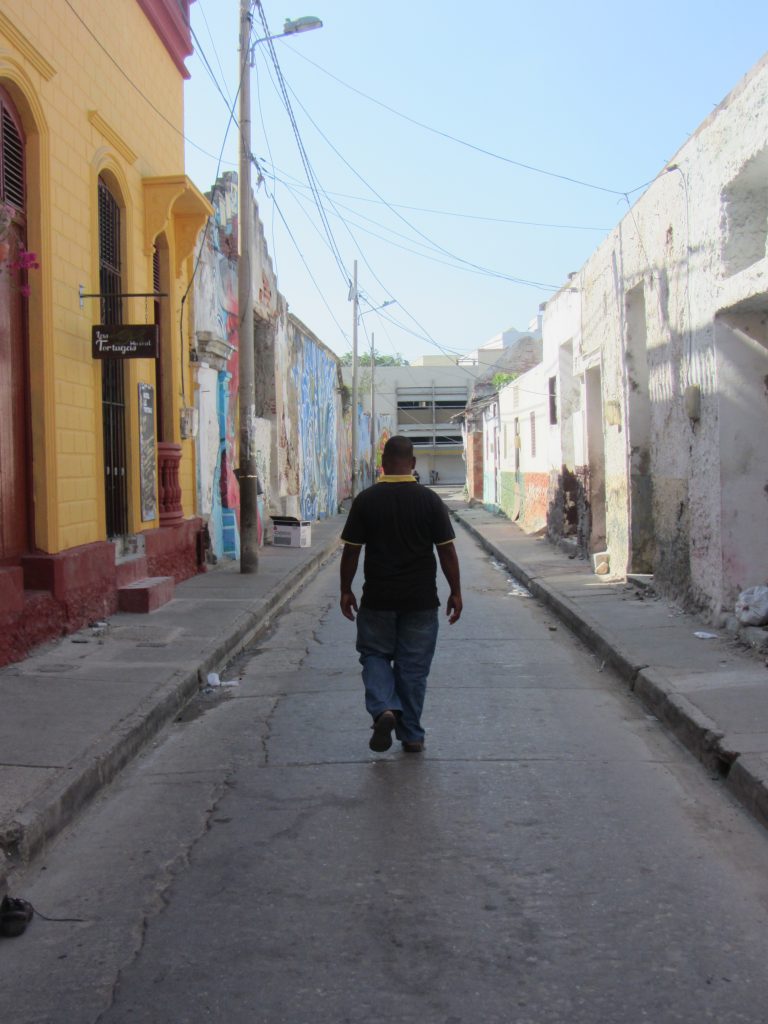
Getsemaní. Photo by Melissa Valle.
The rise of right-wing populism
The rise of right-wing populism across Europe and the United States, with its blatant racist, Islamophobic, and xenophobic dictums, has made it increasingly difficult to suggest that a colorblind strategy for development is reasonably feasible. Organizations such as the US’s Republican Party, The Netherlands’ Party for Freedom, Hungary’s Jobbik, Sweden’s Sweden Democrats, and Austria’s Freedom Party are either explicit about their convictions of white nationalism and white supremacy or engage in dog-whistle politics. These groups, and the masses of people who rally around their pretentions, flagrantly display their growing aggression and contempt for those considered racially, ethnically, nationally and religiously “other.” With parties like Golden Dawn of Greece going as far as to encourage ethnic cleansing, these groups’ disdain for those of Roma, African, Middle Eastern, and Asian origin make urban developers’ and centrist politicians’ assertions of operating in climates of race-neutrality seem nothing short of folly.
Transnational anti-racist movements explicitly confront racial injustice
Contemporary social activism, with its strategic and broad use of social media, relative consistency of message, lack of distinct organizational hierarchies led by charismatic leaders, and intersectional nature (emphasizing race, gender, class, sexual orientation, religion, citizenship, etc.) has led to a critical mass of new and seasoned activists protesting in cities around the world. These social actors explicitly articulate the relationship between race and injustice, making mobilization around racial spatial injustice viable. The use of social media has been particularly pivotal in the grassroots movements’ power to control the narrative about the sources of inequality and to blueprint solutions. Hill (in press) describes “digital counterpublics” as, “any virtual, online, or otherwise digitally networked community in which members actively resist hegemonic power, contest majoritarian narratives, engage in critical dialogues, or negotiate oppositional identities”. The surge in digital counterpublics has enabled both political organizing, solidarity, and far-reaching awareness of the issues and struggles of racialized groups around the world. When activists in the urban spaces of Rio de Janeiro, Brazil, Oakland, Chicago, Ferguson and Baltimore in the United States, or those of Ethiopian descent in Israel take to the streets to protest against anti-Black police violence and widespread racism; when those of Asian descent in the Chinatowns of San Francisco and Boston hold demonstrations to combat urban gentrification-based displacement; when protestors fight against recent refugee policies in New Haven, Connecticut and Canberra, Australia, the reverberations are being felt globally by people facing similar battles, as well as people politically, economically and socially equipped to bring about top-down change.
Conclusion
Racialized and stigmatized groups find themselves constantly fighting to stave off both containment and exclusion in the cases of ghettoization and the creation of refugee camps, as well as expelling in the case of gentrification. Awareness of racial injustice at the urban scale is being magnified due to the movement of newly and previously racialized groups, the accelerated gentrification of racialized communities that is rooted in blatantly race-based strategies, the growth of vocal right-wing politics, and the rise of new anti-racist movements with a global reach. These factors are making it considerably implausible to perpetuate the ruse of race-neutrality that sustains urban development and scholarship premised upon racist practice and/or erasure.
Melissa M. Valle (melissa.valle[at]rutgers.edu), Ph.D. is an Assistant Professor in both the Department of Sociology and Anthropology and the Department of African American and African Studies at Rutgers University-Newark. Her work examines how people determine who is worthy of occupying contested space in a gentrifying neighborhood in Cartagena, Colombia. Her latest article, “The discursive detachment of race from gentrificaton in Cartagena de Indias, Colombia” was published in Ethnic and Racial Studies in January.
All essays on Race, Justice, and the City
Introduction
Liza Weinstein & Meghan Doran
Revealing the Ruse: Shifting the Narrative of Colorblind Urbanism
Melissa M. Valle
Xenophobia and Capitalist Urbanisation Processes in Johannesburg’s ‘African’ Townships
Trevor Ngwane
Black Women and State-Sanctioned Violence in the Brazilian City
Keisha-Khan Y. Perry
The Black City?
AbdouMaliq Simone
Theorizing Racial Justice and the City: Learning from the ‘Tuvel Affair’
Kate Derickson
Related IJURR articles on Race, Justice, and the City
Colonialism, Urbanism, and the World Economy
King, Anthony D.
‘This is a lot like the Bronx, isn’t it?’ Lived Experiences of Marginality in an Argentine Slum.
Auyero, Javier
Three Pernicious Premises in the Study of the American Ghetto
Wacquant, Loic J. D.
Unruly Strangers? The 2001 Urban Riots in Britain
Amin, Ash
Neoliberalism, Race and the Redefining of Urban Redevelopment
Mele, Christopher
Rebels Without a Pause: Hip-hop and Resistance in the City
LaMotte, Martin
© 2017 THE AUTHOR. INTERNATIONAL JOURNAL OF URBAN AND REGIONAL RESEARCH, PUBLISHED BY JOHN WILEY & SONS LTD UNDER LICENSE BY URBAN RESEARCH PUBLICATIONS LIMITED
This is an open access essay under the terms of the Creative Commons Attribution-NonCommercial-NoDerivs License, which permits use and distribution in any medium, provided the original work is properly cited, the use is non-commercial and no modifications or adaptations are made.
